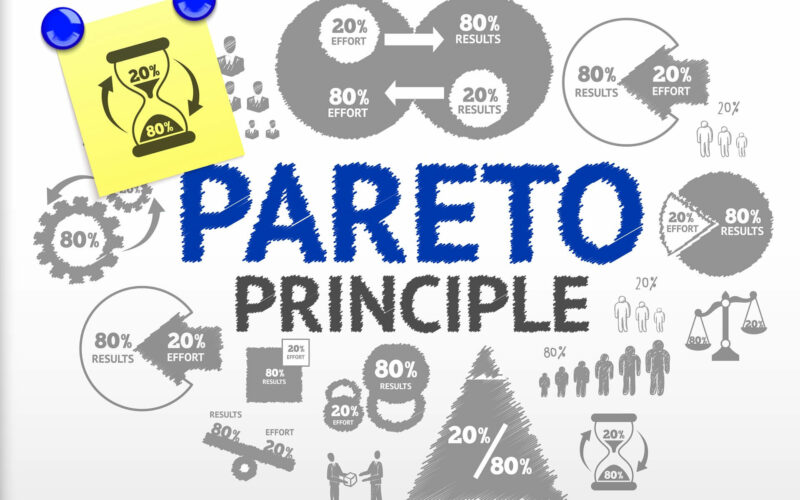Just imagine being able to achieve 80% of your results with just 20% of your efforts. Sounds intriguing, right? This is where the Pareto Principle, also known as the 80/20 rule, comes into play. Understanding this principle can truly revolutionize the way you approach your work, productivity, and overall life.
The Pareto Principle states that, in many situations, roughly 80% of the effects come from 20% of the causes. This concept can be applied in various aspects of life, such as business, economics, time management, and even personal development. By identifying and focusing on the most critical 20% that brings about the significant 80% of the results, you can work smarter, not harder, to achieve your goals.
Whether you are looking to enhance your productivity at work, optimize your business strategies, or improve your personal relationships, understanding and applying the Pareto Principle can be a game-changer. This principle can help you prioritize tasks, identify key areas for improvement, and ultimately increase your efficiency and effectiveness. Stay tuned as we probe deeper into how you can leverage the power of the 80/20 rule in various aspects of your life.
Key Takeaways:
- The Pareto Principle, also known as the 80/20 rule, states that roughly 80% of effects come from 20% of causes.
- This principle is named after economist Vilfredo Pareto, who observed that 80% of Italy’s wealth was owned by 20% of the population.
- The Pareto Principle is applicable in various fields such as business, economics, time management, and productivity.
- Understanding the Pareto Principle can help prioritize tasks, focus on the most critical areas, and increase efficiency.
- It suggests that not all inputs or efforts contribute equally to the desired output, so it is necessary to identify and concentrate on the most impactful ones.
- Businesses can use the Pareto Principle to identify their most profitable customers, products, or services to maximize their returns.
- By leveraging the insights provided by the Pareto Principle, individuals and organizations can achieve more with less effort by concentrating on the vital few rather than the trivial many.
Understanding the 80/20 Rule
The Basic Premise of the Pareto Principle
It is vital to understand the fundamental concept of the Pareto Principle, also known as the 80/20 rule, to grasp its significance in various aspects of life. The principle suggests that roughly 80% of outcomes result from 20% of causes. This imbalance implies that a minority of inputs have a significant impact on the majority of results, emphasizing the importance of focusing on the vital few rather than the trivial many.
What makes the Pareto Principle compelling is its versatility in different scenarios. Whether in business, economics, or personal productivity, the principle can offer valuable insights into where to concentrate efforts for maximum effectiveness. By recognizing the uneven distribution of outcomes, individuals and organizations can prioritize tasks, resources, and goals to optimize their performance and achieve better results with less effort.
Implementing the 80/20 rule requires a shift in mindset towards strategic thinking and resource allocation. By identifying the most influential factors that drive success, one can streamline processes, eliminate inefficiencies, and increase overall productivity. Embracing this principle empowers individuals to work smarter, not harder, by focusing on activities that yield the greatest returns and avoiding distractions that do not contribute significantly to the desired outcomes.
Mathematical Representation and Misinterpretations
Principle
Many people misinterpret the Pareto Principle as a strict 80/20 split, but it is crucial to understand that the ratio is a general guideline rather than a fixed rule. The principle is about highlighting the imbalance in cause-and-effect relationships, where a small proportion of efforts lead to a majority of results. While the numbers may vary (e.g., 70/30 or 90/10), the underlying concept remains consistent in emphasizing the significance of focusing on the critical few over the trivial many.
The Pareto Principle in Economics
Application in Wealth Distribution
You may have heard of the Pareto Principle, also known as the 80/20 rule, which suggests that roughly 80% of effects come from 20% of causes. When applied to wealth distribution in economics, this principle shows that a small percentage of the population holds a large majority of the wealth. This phenomenon is evident in various economies around the world, where a small elite has a disproportionately large share of the wealth compared to the rest of the population.
This skewed distribution can have significant implications for societies as it can lead to increased inequality and social unrest. Governments often grapple with the challenge of addressing this imbalance through policies aimed at redistributing wealth more equitably. Understanding the Pareto Principle in wealth distribution is crucial for policymakers and economists to create more inclusive economic systems that benefit a larger portion of the population.
While the Pareto Principle in wealth distribution highlights the concentration of wealth in the hands of a few, it also underscores the importance of addressing systemic issues that perpetuate this inequality. By recognizing the impact of this principle, stakeholders can work towards creating a more balanced economic environment that promotes sustainable growth and prosperity for all members of society.
Impact on Market Economics
To investigate into the impact of the Pareto Principle on market economics, we must consider how this principle influences consumer behavior, market dynamics, and overall economic performance. In many markets, roughly 20% of customers contribute to about 80% of revenue, emphasizing the significance of targeting key consumer segments for business success.
For instance, companies can use this understanding to tailor their marketing strategies towards high-value customers, thereby maximizing their return on investment. However, it is important to strike a balance between catering to the needs of this valuable segment while also ensuring a more inclusive approach that benefits a broader customer base. By leveraging the Pareto Principle in market economics, businesses can optimize their operations and drive sustainable growth in competitive markets.
For instance, businesses can analyze their product portfolio to identify which products generate the most revenue and focus on improving or promoting those particular offerings. This strategy can help companies streamline their resources and enhance their market competitiveness by catering to the needs of their most profitable customer segments. By applying the Pareto Principle to market economics, businesses can achieve greater efficiency and profitability in their operations.
The Pareto Principle in Business
Improving Productivity and Efficiency
Keep in mind that the Pareto Principle can be a game-changer when it comes to improving productivity and efficiency in your business. By focusing on the 20% of tasks that yield 80% of the results, you can streamline operations and allocate resources more effectively. Identify the key drivers of success in your business and prioritize them to maximize your output.
Implementing the 80/20 rule can also help you identify inefficiencies and bottlenecks that may be hindering your business’s performance. By analyzing where your efforts are most fruitful, you can eliminate or delegate tasks that are less impactful, freeing up time and resources for more important activities. This targeted approach can lead to significant improvements in overall efficiency.
Furthermore, by constantly reassessing and re-evaluating your operations with the Pareto Principle in mind, you can adapt to changing circumstances and stay ahead of the competition. Continuously striving to optimize your processes based on the 80/20 rule will enhance your business’s agility and resilience in the face of challenges.
Inventory Management with the 80/20 Rule
Improving inventory management using the 80/20 rule involves focusing on the 20% of products that generate 80% of your sales. By prioritizing these high-demand items, you can reduce stockouts, optimize warehouse space, and improve cash flow. This targeted approach to inventory control helps prevent overstocking of slow-moving items while ensuring you have enough of the fast-moving products to meet customer demand.
Pareto
The Pareto Principle, also known as the 80/20 rule, is a valuable concept that can revolutionize how businesses approach sales and marketing strategies. By recognizing that a small percentage of efforts lead to the majority of results, organizations can focus their resources on the most impactful activities. This targeted approach can help businesses achieve significant improvements in their sales and marketing outcomes.
The 80/20 Rule in Sales and Marketing
Rule: Applying the 80/20 rule in sales and marketing allows businesses to identify their most profitable customers, products, or marketing channels. By concentrating efforts on these top performers, companies can boost revenue, enhance customer relationships, and allocate resources more efficiently. Understanding the power of the 80/20 rule in sales and marketing can give businesses a competitive edge in a crowded marketplace.
A
Strategic Decision-Making and the Pareto Principle: In strategic decision-making, businesses can leverage the Pareto Principle to focus on the vital few factors that drive the majority of outcomes. By identifying and prioritizing these key influencers, organizations can make informed decisions that have a significant impact on their bottom line. Embracing the 80/20 rule in strategic planning can lead to more effective resource allocation and sustainable growth.
Personal Development and the Pareto Principle
Despite the multitude of self-help books, seminars, and courses available on personal development, many individuals still struggle to achieve their goals and reach their full potential. This is where the Pareto Principle, or the 80/20 rule, comes into play. By understanding and applying this principle to various aspects of personal development, individuals can become more efficient, productive, and successful in their endeavors.
Time Management and Prioritization
An crucial aspect of personal development is effective time management and prioritization. By applying the Pareto Principle, individuals can identify the 20% of tasks that yield 80% of the results and focus their time and energy on these high-impact activities. This approach helps individuals avoid wasting time on low-value tasks and ensures that they are consistently making progress towards their goals.
Furthermore, prioritizing tasks based on the 80/20 rule allows individuals to allocate their time more efficiently, leading to increased productivity and a greater sense of accomplishment. By focusing on the most critical tasks first, individuals can tackle their most challenging goals head-on and make significant strides in their personal development journey.
Ultimately, mastering time management and prioritization through the lens of the Pareto Principle can lead to greater efficiency, effectiveness, and overall success in personal development endeavors.
The 80/20 Rule for Personal Goals and Success
Personal development often involves setting and achieving goals that align with one’s values, aspirations, and vision for the future. The Pareto Principle can be a powerful tool for guiding individuals towards success in these areas. By focusing on the 20% of actions that result in 80% of progress towards their goals, individuals can work smarter, not harder, to achieve meaningful results.
Personal growth and success can be accelerated by identifying key actions, habits, or strategies that have the most significant impact on one’s progress. By honing in on these critical factors, individuals can optimize their efforts and make steady strides towards their personal and professional aspirations.
Embracing the 80/20 rule in personal goal setting and achievement empowers individuals to maximize their potential, leverage their strengths, and overcome obstacles that may have previously hindered their progress.
Work-Life Balance and the Pareto Principle
Development and personal growth are not limited to professional success but also encompass achieving a healthy work-life balance. Balancing the demands of work, family, and personal well-being can be challenging, but the Pareto Principle offers valuable insights into prioritizing and optimizing various aspects of life.
By applying the 80/20 rule to work-life balance, individuals can identify key activities that contribute most to their overall well-being and happiness. This approach helps individuals allocate their time and energy in a way that promotes both professional success and personal fulfillment, creating a harmonious equilibrium.
Striking a balance between work and personal life is crucial for long-term happiness, productivity, and overall well-being. The Pareto Principle serves as a guiding principle for individuals seeking to prioritize what truly matters, cultivate meaningful relationships, and nurture their own health and happiness amidst life’s numerous demands.
The Pareto Principle in Quality Management
Origins in Quality Control
Not many people know that the Pareto Principle, also known as the 80/20 rule, has its roots in quality management. Developed by quality management pioneer Joseph M. Juran, this principle revolutionized the way businesses approached quality control. Juran observed that a small percentage of defects were responsible for the majority of problems in production processes. This led to the realization that focusing efforts on addressing these critical few issues could result in significant improvements in quality.
For decades, the Pareto Principle has been a cornerstone of quality control methodologies such as Six Sigma and Total Quality Management. By identifying and prioritizing the factors that contribute most significantly to quality issues, companies can allocate resources effectively to make the greatest impact. This principle has proven to be a powerful tool in driving continuous improvement and achieving higher levels of customer satisfaction.
Applying the Pareto Principle in quality management involves analyzing data to identify the vital few factors that have the most significant impact on quality outcomes. By concentrating on addressing these critical issues first, organizations can streamline their efforts and resources, leading to more efficient and effective quality control processes.
The 80/20 Rule in Modern Quality Management Systems
With advancements in technology and data analytics, the 80/20 rule has become even more relevant in modern quality management systems. By leveraging data-driven insights, companies can pinpoint the key areas where improvements will have the most substantial impact on quality. This targeted approach allows organizations to optimize their processes and resources to achieve optimal results.
Principle: Embracing the Pareto Principle in quality management is necessary for organizations striving for excellence. By focusing on the critical few factors that drive quality outcomes, companies can prioritize their efforts and resources effectively. This results in more efficient processes, higher levels of customer satisfaction, and ultimately, greater success in the marketplace.
The Pareto Principle in Software and Technology
Many software development teams and technology companies apply the Pareto Principle, also known as the 80/20 rule, to optimize their processes and outcomes. This principle suggests that roughly 80% of effects come from 20% of causes. When applied to software and technology, this rule can help teams focus their efforts on the most impactful areas for improvement.
Optimizing User Experience
Software companies can use the Pareto Principle to identify the 20% of features that contribute to 80% of user satisfaction. By prioritizing these features, developers can enhance the user experience and deliver products that meet the most critical needs of their customers. This approach can lead to higher user engagement, retention, and overall satisfaction with the software.
Prioritizing Software Features and Bug Fixes
An necessary aspect of software development is prioritizing features and bug fixes effectively. By applying the Pareto Principle, teams can focus on addressing the 20% of features that will have the most significant impact on user experience and functionality. Similarly, identifying the 20% of bugs causing 80% of issues allows developers to allocate resources efficiently to improve overall software quality.
It is crucial for software development teams to regularly assess and prioritize their tasks based on the Pareto Principle to ensure that they are maximizing their impact and delivering the most value to users. By focusing on the critical few features and bugs that have the most significant influence, teams can streamline their development process and produce higher-quality software products.
The Pareto Principle in Cybersecurity
Technology companies can utilize the Pareto Principle in cybersecurity to prioritize security measures based on their effectiveness and potential impact. By identifying the 20% of vulnerabilities that pose the most significant threat to the organization, cybersecurity teams can allocate resources strategically to protect sensitive data and systems. This targeted approach can help companies strengthen their defenses and mitigate the most substantial risks.
Technology
To protect against cyber threats effectively, organizations must focus on addressing the most critical vulnerabilities that could lead to severe consequences if exploited. By applying the Pareto Principle in cybersecurity, companies can prioritize their security efforts where they will have the most significant impact and strengthen their overall defense posture.
The Pareto Principle in Health and Lifestyle
Diet, Nutrition, and the 80/20 Rule
Your diet plays a vital role in your overall health and well-being. For many, adhering to a strict diet 100% of the time can be challenging. This is where the 80/20 rule can be beneficial. By following this principle, you aim to eat healthily 80% of the time while allowing yourself some flexibility for indulgences the remaining 20% of the time. This approach can help you maintain a balanced and sustainable diet while still enjoying your favorite treats in moderation.
When applying the 80/20 rule to your nutrition, focus on prioritizing nutrient-dense foods such as fruits, vegetables, whole grains, lean proteins, and healthy fats during the 80% of disciplined eating. This ensures that your body receives important vitamins, minerals, and antioxidants for optimal functioning. By allowing yourself occasional treats or less nutritious foods in the remaining 20%, you can prevent feelings of deprivation and avoid binge eating episodes.
Be mindful of, the key to successfully implementing the 80/20 rule in your diet is consistency and mindfulness. Strive to make healthy choices the majority of the time while also savoring your favorite indulgences in moderation. By striking this balance, you can cultivate a positive relationship with food and maintain a sustainable approach to nutrition.
Exercise and the Pareto Principle
Principle: Concerning exercise, the Pareto Principle can be applied to optimize your workout routine. This principle suggests that approximately 80% of your results come from 20% of your efforts. This means that by identifying the most effective exercises or activities that yield the greatest benefits, you can streamline your workouts for maximum efficiency.
This approach involves focusing on high-impact exercises that target multiple muscle groups simultaneously, such as squats, deadlifts, push-ups, and lunges. By incorporating these compound movements into your routine, you can work more muscles in less time, leading to improved strength, endurance, and overall fitness. Additionally, high-intensity interval training (HIIT) is a time-efficient way to burn calories and boost metabolism, aligning with the Pareto Principle’s emphasis on effectiveness.
By applying the Pareto Principle to your exercise regimen, you can make the most of your time at the gym or during home workouts. Prioritize exercises that deliver substantial results in minimal time, allowing you to achieve your fitness goals efficiently. Be mindful of, quality over quantity is key in optimizing your workout routine and overall physical well-being.
Stress Management and Well-being
One of the important aspects of maintaining overall health and well-being is effective stress management. Stress can have a significant impact on both your physical and mental health, leading to various adverse effects if left unaddressed. By incorporating the Pareto Principle into your stress management strategies, you can focus on the key activities that provide the most significant relief and benefits.
One effective way to manage stress is through mindfulness practices such as meditation, deep breathing exercises, or yoga. These techniques can help calm the mind, reduce anxiety, and promote relaxation, aligning with the Pareto Principle’s emphasis on prioritizing activities with the most significant impact. Additionally, regular physical activity, adequate sleep, and maintaining social connections are vital factors in stress management that should not be overlooked.
With a proactive approach to stress management that focuses on the most important and effective strategies, you can better cope with daily stressors and improve your overall well-being. Remember to prioritize self-care and relaxation to counteract the negative effects of stress and maintain a healthy balance in your life.
Challenges and Criticisms of the Pareto Principle
Misapplication and Overuse of the 80/20 Rule
Once again, the Pareto Principle, also known as the 80/20 rule, is not without its challenges and criticisms. One of the biggest issues with the principle is its misapplication and overuse in various contexts. The essence of the Pareto Principle lies in the observation that a small number of causes (20%) is responsible for a large percentage (80%) of the effects. However, some individuals and organizations tend to oversimplify complex situations by assuming that the rule applies universally.
The danger lies in misapplying the 80/20 rule without a thorough understanding of the underlying factors at play. This oversimplification can lead to skewed decision-making and potentially overlooking critical variables that may not follow the 80/20 distribution. It’s crucial to exercise caution and critical thinking when applying the Pareto Principle to avoid unintended consequences.
Moreover, the overreliance on the 80/20 rule can result in a tunnel vision approach, where only the “vital few” are focused on, neglecting the “trivial many” that may still hold significance. While the principle can be a valuable tool for prioritization and resource allocation, it should not be treated as a one-size-fits-all solution to every problem or scenario.
Limitations in Predictive Power and Accuracy
With any heuristic or principle, there are inherent limitations to its predictive power and accuracy. The Pareto Principle, while insightful and widely applicable, may not always capture the full complexity of a situation. It is important to recognize that the 80/20 distribution is a general rule of thumb rather than an absolute law of nature. Applying the 80/20 rule requires a nuanced understanding of the specific context and factors involved to derive meaningful insights.
Another consideration is that the Pareto Principle may not hold true in every scenario and industry. Variability in data, shifting market dynamics, and unique organizational structures can influence the distribution of causes and effects. It’s necessary to exercise caution when extrapolating the 80/20 rule to diverse and evolving contexts, as blindly applying the principle can lead to misguided decisions and missed opportunities.
Extending the Pareto Principle
Beyond 80/20: Variations of the Pareto Rule
The Pareto Principle, famously known as the 80/20 rule, suggests that roughly 80% of results come from 20% of causes. However, this ratio is not set in stone. Various variations of the Pareto Principle exist, such as the 90/10 rule, where 90% of outcomes stem from 10% of efforts. These variations highlight that the principle’s essence lies in the uneven distribution of inputs and outputs, rather than a specific ratio.
Moreover, some applications of the Pareto Principle reveal that the distribution may not be as extreme as 80/20. In certain cases, it might even be a 70/30 or 95/5 split. Regardless of the specific percentages, the key takeaway remains consistent – a small percentage of inputs lead to a large percentage of outputs in various scenarios, from business to personal productivity.
Understanding these variations allows individuals and organizations to tailor their strategies accordingly. By identifying the critical few inputs that drive the majority of results, they can focus their efforts on the most impactful areas and maximize efficiency and productivity in their endeavors.
Integration with Other Theories and Methodologies
Methodologies such as Six Sigma, Lean Management, and Agile Project Management can benefit greatly from incorporating the Pareto Principle into their frameworks. By integrating the principle with these methodologies, organizations can pinpoint the vital few factors that influence quality, streamline processes, and prioritize tasks based on their impact.
Additionally, integrating the Pareto Principle with other management theories like the Theory of Constraints or Kaizen can enhance overall strategic decision-making and continuous improvement efforts. This integration enables a more holistic approach to problem-solving and optimization, ensuring that limited resources are efficiently allocated for maximum results.
Extending the application of the Pareto Principle beyond traditional business contexts to personal development and time management can also yield significant benefits. By identifying the critical few tasks or activities that drive the most significant outcomes, individuals can focus on what truly matters, leading to increased productivity and success in various aspects of their lives.
Using the Pareto Principle Effectively
Identifying the Vital Few in Different Contexts
All successful application of the Pareto Principle starts with identifying the vital few, the 20% that contribute to 80% of the results. On a personal level, this could mean recognizing that 20% of your activities lead to 80% of your happiness or productivity. In business, it could be acknowledging that 20% of your clients generate 80% of your revenue. Understanding where this principle applies in different contexts is vital for effective implementation.
By applying the Pareto Principle, you can prioritize tasks and focus on the most impactful ones, leading to more efficient outcomes. For example, if you identify the 20% of marketing strategies that bring in 80% of your customers, you can allocate more resources to those specific strategies. This strategic approach can help you make better decisions and maximize your efforts for greater results.
Contexts such as project management, time management, or even personal development can benefit from the Pareto Principle. Recognizing that a small portion of your efforts leads to the majority of your results can revolutionize the way you approach tasks. By focusing on the vital few, you can streamline your processes and achieve more with less effort.
Implementing Changes Based on the 80/20 Analysis
Effectively implementing changes based on the 80/20 analysis requires strategic planning and a willingness to prioritize. By identifying the key factors that drive the majority of your results, you can make informed decisions on where to allocate your resources. For businesses, this could mean restructuring operational processes to focus on the most profitable products or services.
Understanding the impact of the Pareto Principle can lead to significant improvements in both productivity and profitability. By optimizing resources based on the 80/20 analysis, businesses and individuals can achieve more with less. This approach fosters a culture of efficiency and effectiveness, driving success in various endeavors.
Whether you are a small business owner, a project manager, or an individual looking to enhance personal productivity, the Pareto Principle can be a powerful tool. By focusing on the vital few and implementing changes based on the 80/20 analysis, you can unlock new levels of success and achieve your goals more effectively.
Monitoring and Adjusting Strategies Over Time
Continuous monitoring and adjusting of strategies over time are crucial for long-term success. Analysis of outcomes based on the Pareto Principle can provide valuable insights into the effectiveness of your actions. By regularly reviewing the vital few and their impact on your results, you can adapt your strategies to optimize performance.
Regularly assessing which tasks or activities contribute the most to your goals allows for continuous improvement. This iterative process of monitoring and adjusting ensures that you stay focused on what matters most and avoid wasting time on less impactful activities. By staying agile and responsive to changes, you can maintain a competitive edge and achieve sustainable success.
Contexts such as market trends, customer preferences, or individual productivity levels can evolve over time. Adapting your strategies based on the changing landscape is vital for staying relevant and achieving continued growth. By incorporating the Pareto Principle into your monitoring and adjustment processes, you can stay ahead of the curve and maximize your success potential.
Summing up
Considering all points discussed about the Pareto Principle, it becomes clear that this rule has a wide-reaching impact across various aspects of our lives. By understanding and utilizing the 80/20 rule, individuals and organizations can focus their efforts on the most critical tasks that yield the greatest results. This principle serves as a powerful tool for prioritization, efficiency, and effectiveness in decision-making.
It is important to remember that the Pareto Principle is not a one-size-fits-all solution, but rather a guideline to help identify the most important factors in a given situation. By recognizing the imbalance between inputs and outputs, we can leverage this knowledge to optimize our time, resources, and energy. The 80/20 rule serves as a valuable framework for strategic planning, productivity enhancement, and goal achievement.
In short, the Pareto Principle is a timeless concept that continues to hold relevance in today’s fast-paced world. By embracing the 80/20 rule and applying it judiciously, individuals and organizations can unlock new levels of efficiency and success. Understanding the power of prioritization and focusing on the vital few tasks that drive the majority of results can lead to significant improvements in productivity and overall performance. Mastery of the Pareto Principle is not only a key to success but also a pathway to a more balanced and fulfilling life.
FAQ
Q: What is the Pareto Principle?
A: The Pareto Principle, also known as the 80/20 Rule, states that roughly 80% of the effects come from 20% of the causes. It is a principle that suggests a minority of inputs or efforts lead to a majority of results.
Q: Who is Vilfredo Pareto?
A: Vilfredo Pareto was an Italian economist who first observed the Pareto Principle in the early 20th century. He noted the unequal distribution of wealth in society where 80% of the land in Italy was owned by 20% of the population.
Q: How is the Pareto Principle applied in business?
A: In business, the Pareto Principle is often used to prioritize tasks and resources. It helps identify key areas where resources can be focused to achieve maximum results. By identifying the most critical 20%, businesses can optimize their efforts.
Q: Can the Pareto Principle be applied to personal productivity?
A: Yes, the Pareto Principle can be applied to personal productivity as well. By focusing on the 20% of tasks that yield 80% of the results, individuals can work more efficiently and effectively to achieve their goals.
Q: How can one identify the key 20% in a given situation?
A: To identify the key 20% in a given situation, one needs to analyze the data and outcomes to see which inputs are producing the most significant results. This requires careful observation, measurement, and analysis to determine where efforts should be concentrated.
Q: What are the benefits of using the Pareto Principle?
A: The benefits of using the Pareto Principle include increased efficiency, better resource allocation, improved decision-making, and a focus on high-impact activities. It helps in prioritizing tasks and resources to maximize results.
Q: Are there any limitations to the Pareto Principle?
A: While the Pareto Principle is a valuable concept, it is not a universal law and may not always hold true in every situation. The 80/20 split is not fixed and can vary, so it should be used as a guideline rather than a strict rule.


![10 Must-Have AI Tools for Startups & Small Businesses [2026]](https://smartgeekguide.com/wp-content/uploads/2025/10/top-10-ai-tools-for-startups-2026-xmg-360x240.jpg)






